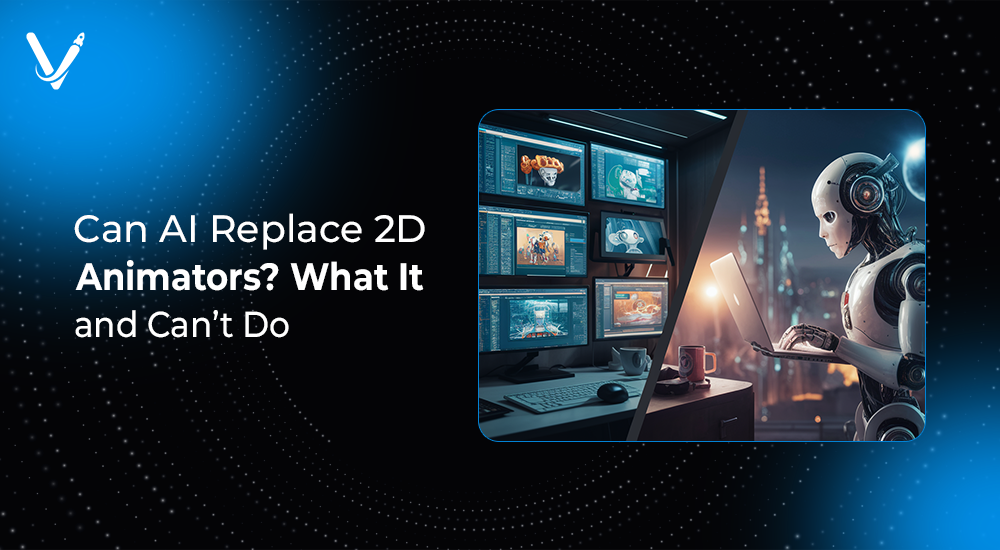Can AI Replace 2D Animators? What It Can and Can’t Do


- Aug 18, 2025



Animation has always been a blend of art and technology. Traditional 2D animation brought to life beloved classics through thousands of hand-drawn frames, and later, digital tools sped up the process without taking away the human artistry behind it. Now, a new player has entered the stage—Artificial Intelligence. AI has sparked a global debate across creative industries, and 2D animation is no exception.
Can AI actually replace 2D animators? Or does it simply reshape their role? This article explores both sides of the conversation in detail. We’ll examine what AI is capable of doing in the world of animation, the challenges it faces, where human creativity still reigns supreme, and how the future may look when animators and AI work together.
By the end, you’ll have a clear picture of what AI can and can’t do in 2D animation, and what that means for professionals, studios, and aspiring animators worldwide.
Artificial Intelligence has rapidly advanced in creative applications, moving beyond analytics and automation into areas like art, music, design, and filmmaking. With the rise of generative AI models, tools now exist that can produce realistic images, convert text into video, and even mimic artistic styles with remarkable accuracy.
In animation, this evolution has sparked interest because of the sheer amount of repetitive, time-consuming work involved. Clean-up, tweening (drawing the frames between keyframes), lip-syncing, and background generation are all areas where AI shows potential. Studios are eager to reduce costs and timelines, and animators are curious (and sometimes concerned) about how these tools will shape their craft.
To understand what AI is stepping into, it’s important to revisit how traditional 2D animation is made. A typical process involves:
Every stage requires creativity, technical skill, and hours of focused work. AI enters as an assistant—sometimes impressive, sometimes flawed—in these stages.
One of the most repetitive tasks in animation is tweening. AI models can now generate smooth in-betweens from just a handful of keyframes. This dramatically reduces the workload for junior animators, who traditionally spent hours drawing transitional movements.
Colorization tools powered by AI can fill in character designs quickly and even match the style of reference art. This saves time, especially in large-scale productions where hundreds of frames need consistent coloring.
AI tools like Papercup or DeepMotion automate mouth movements by analyzing audio tracks, syncing dialogue with characters’ lip shapes almost instantly. This feature helps cut production time without sacrificing much quality.
AI can mimic artistic styles, transforming simple sketches into polished frames that reflect a desired aesthetic. This is useful for maintaining consistency across teams or adapting to multiple art directions.
With text-to-image AI models, animators can instantly generate complex backgrounds or prop designs. While not always production-ready, these assets provide a strong foundation for refinement.
AI excels in brainstorming and visual exploration. Animators can test out character variations, storyboards, and color palettes within minutes instead of days.
AI can produce frames, but it doesn’t understand narrative nuance. Storytelling requires empathy, cultural awareness, and human imagination—qualities AI lacks.
Fluid motion that conveys weight, emotion, and individuality remains a challenge. AI-generated motion often looks too stiff or uncanny, especially for expressive characters.
While AI is great at one-off images, maintaining continuity across thousands of frames is far harder. Slight inconsistencies in line thickness, proportions, or color grading can break immersion.
AI can remix existing data but cannot truly invent. It doesn’t dream up characters with backstories, symbolic meaning, or subtle humor—it needs a human vision to follow.
AI models often train on existing art without permission, raising questions about plagiarism, ownership, and respect for original artists. For professional studios, this creates legal and ethical dilemmas.
Instead of replacing animators, AI seems better suited as a collaborative tool. Here’s how the partnership works:
In short, AI handles the heavy lifting, while humans provide the artistry that resonates with audiences.
Studios are cautiously optimistic. Independent creators see AI as an opportunity to produce professional-looking work faster, while larger studios focus on hybrid pipelines where AI tools support—but do not replace—animation teams.
Animators themselves are divided. Some fear job displacement, while others embrace AI as a way to focus on higher-level creativity instead of repetitive tasks. Much like how digital tools once replaced hand-drawn cell painting, AI may simply become the next evolution in the toolkit.
AI is not the death of 2D animation—it’s a transformation. By automating repetitive processes and expanding creative possibilities, AI frees animators to focus on storytelling and artistry. Just as digital tools once shifted the industry, AI will redefine how 2D animation is produced, but human creativity will remain irreplaceable.
At Vasundhara Infotech, we embrace this evolving synergy of art and technology. Our team specializes in blending traditional creativity with cutting-edge innovation to deliver world-class digital experiences. If you’re ready to explore how AI can empower your animation or creative project, let’s start building the future together. Get in touch with us.
Copyright © 2025 Vasundhara Infotech. All Rights Reserved.